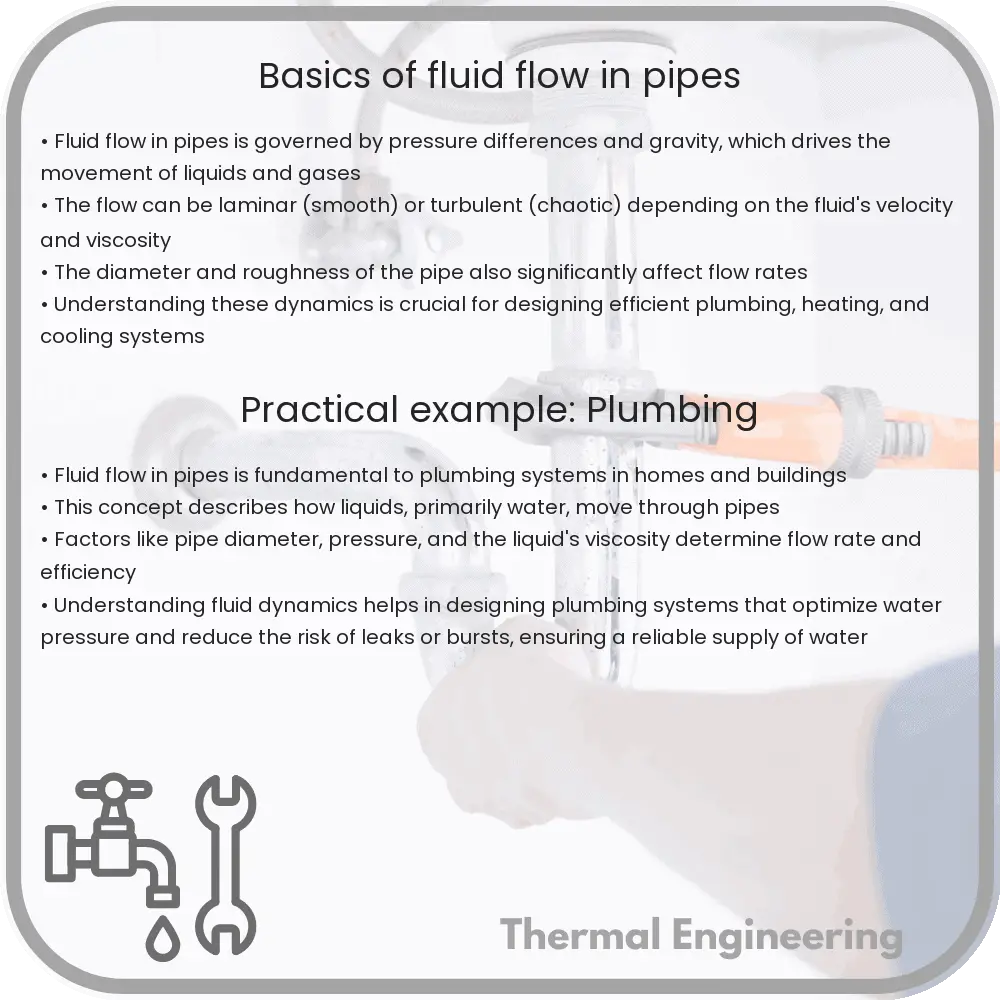This article provides a detailed examination of fluid flow in pipes, focusing on concepts like laminar and turbulent flow, Reynolds number, and the Bernoulli Equation.

Understanding Fluid Flow in Pipes
Fluid mechanics is an essential field of physics and engineering that deals with the behavior of fluids in various states. An understanding of how fluids flow through pipes is critical for engineers designing systems involved in water supply, oil transport, and chemical processing. In this article, we’ll explore the fundamental concepts of fluid flow in pipes, including types of flow, equations governing the flow, and pertinent parameters that influence flow behavior.
Types of Fluid Flow
Fluid flow within pipes can occur in different regimes, primarily characterized as either laminar or turbulent flow:
- Laminar flow: Fluid particles move in smooth, orderly layers. Laminar flow typically occurs at lower velocities and can be modeled by simpler, linear equations. It is generally characterized by a Reynolds number (Re) of less than 2000.
- Turbulent flow: At higher velocities, the flow becomes chaotic and irregular. Turbulent flow involves mixing across layers and is much harder to model accurately. It occurs when Re > 4000.
- Transitional flow: Occurs between laminar and turbulent flows, typically in the range of Re = 2000 to 4000.
Reynolds Number
The Reynolds number (Re) is a dimensionless quantity in fluid mechanics used to predict flow patterns in different fluid flow situations. It is defined as:
Re = (ρ * v * D) / μ
- ρ (rho) – the density of the fluid (kg/m3).
- v – the velocity of the fluid within the pipe (m/s).
- D – the diameter of the pipe (m).
- μ (mu) – the dynamic viscosity of the fluid (Pa*s).
This equation helps determine whether the flow is laminar or turbulent, which in turn affects how the flow can be analyzed and calculated.
The Bernoulli Equation
One of the fundamental equations used in the study of fluid flow is the Bernoulli Equation, which applies to incompressible flows and is derived from the conservation of energy principle. It is expressed as:
P + (1/2)*ρ*v2 + ρ*g*h = Constant
- P – the pressure within the fluid (Pa).
- ρ (rho) – the density of the fluid (kg/m3).
- v – the velocity of the fluid (m/s).
- g – acceleration due to gravity (9.81 m/s2).
- h – the height relative to a reference point (m).
The Bernoulli Equation is essential when analyzing fluid flow in systems where the elevation difference and the pressure difference play significant roles, such as in siphons and venturi meters.
Practical Considerations
When applying these principles to real-world engineering problems, several practical aspects need to be considered:
- Friction: Fluid flow in pipes is generally affected by friction, which can be described by the Darcy-Weisbach equation. This equation relates the frictional head loss due to the flow of the fluid in a pipe.
- Pipe Roughness: The inner surface of a pipe can vary greatly depending on the material, impacting the flow rate and pressure loss.
- Changes in Diameter: Changes in pipe diameter along the flow path cause changes in fluid velocity and pressure, according to the continuity equation and Bernoulli’s principle.
Understanding the dynamics of fluid flow in pipes is vital for the design and maintenance of efficient piping systems in various industries such as civil, chemical, and mechanical engineering. By mastering the basics discussed above, engineers can predict and manipulate fluid behavior to meet their requirements effectively.